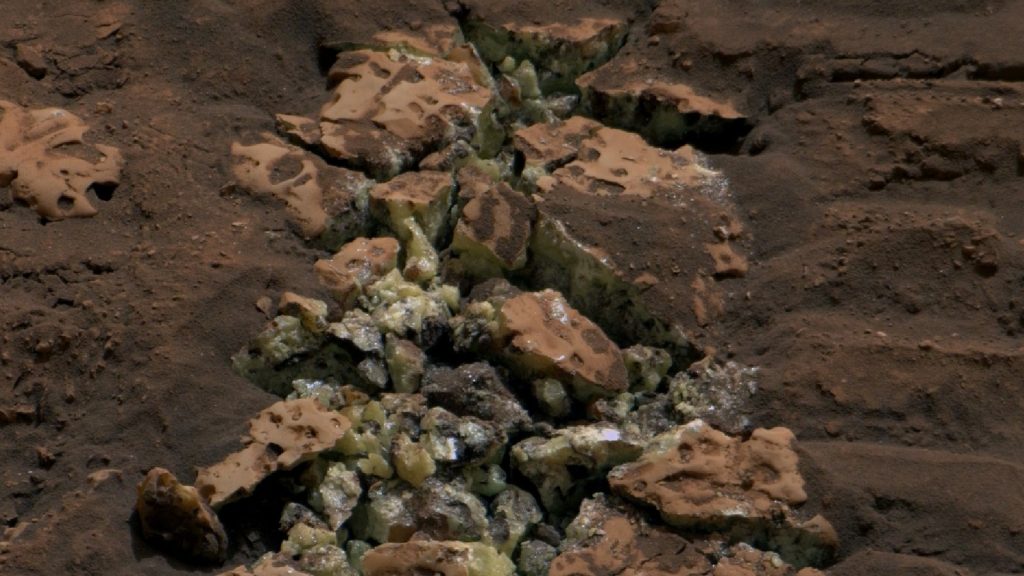National Aeronautics and Space Administration (NASA)The Curiosity rover’s latest “stunning” discovery Mars They found yellow-green crystals of pure sulfur, something never seen before on Mars.
Scientists say the rover made the unprecedented discovery when it drove over rock formations and cracked one of them while exploring the Gediz Canyon strait. The unexpected excavation revealed a new entity that “should not be there,” marking the first discovery in the last 30 years of exploration of the planet.
Apparently, the serendipitous discovery was like “finding an oasis in the desert”, says Ashwin Vasavada. Curiosityproject scientist at NASA’s Jet Propulsion Laboratory in Pasadena, California.
And it’s not like the rover just happened to find a handful of rocks made of pure sulfur; rather, scientists encountered many tons of rocks throughout the field.
“Discovering the strange and unexpected is what makes planetary exploration so exciting,” Vasavada added.
Also read | Did The Simpsons predict that Kamala Harris would become US president? Shocking theory emerges
@MarsCuriosity added this exciting event to their online journal and posted it online.
“*clang* I ran over a rock and there was a crystal in it!
It’s pure sulfur (it has no smell). Elemental sulfur is something never seen before on Mars. We don’t know much about these yellow crystals yet, but my team is excited to find out.”
Curiosity’s official X/Twitter update left many wondering why the sulfur discovery doesn’t smell: “Hello, people associate sulfur with the smell of rotten eggs, which is the result of hydrogen sulfide gas. However, elemental sulfur is odorless. It only forms under a narrow range of conditions that scientists have not linked to the history of this site,” Curiosity tweeted. Mars RoverThis was quickly explained on the page.
Why is this discovery groundbreaking?
As already established, sulfur is a key ingredient for life, being one of the six building blocks along with carbon, hydrogen, nitrogen, oxygen, and phosphorus. What makes this discovery even more groundbreaking is that together these elements make up 98% of life on Earth. This consideration has once again led scientists into the black hole of possibilities and questions surrounding the conditions and history of the Red Planet that could support life.
Check out Curiosity’s discoveries:
Also read | Indian man ‘fired from CrowdStrike’ has ‘no idea’ why he was fired: Another employee meme?
Mars rovers have previously found sulfates, or salts containing sulfur, formed on Mars by the evaporation of water. Scientists working on the project found white calcium sulfate (gypsum) on numerous cracks on the Martian surface, suggesting the presence of hard-water deposits caused by ancient groundwater flows. But finding “pure sulfur” wasn’t even “on their bingo card,” Vasavada exclaimed.
Vasavada also noted that although the rocks have a “beautiful, translucent, crystalline texture,” their discovery on the Martian surface and exposure to weathering have caused them to blend into the Martian surface, creating a camouflage effect that is primarily distinguished by their orange hue.
They ultimately uncovered the rock’s “incredible internal texture and color” and used the spacecraft’s resources to analyze it, with the data proving it to be pure sulfur.
Similar to this serendipitous discovery, NASA’s Spirit rover also accidentally found nearly pure silica, again suggesting that hot springs and steam vents may have once been present on the planet. This discovery also suggests that, at the very least, if they once existed, their presence could create favorable conditions for microbial life.
Also read | National Ice Cream Day deals: Free offerings at Wendy’s, Dairy Queen and more
Curiosity didn’t actually kill the cat, and by a happy coincidence he found his friend again.
The Curiosity rover stumbled upon the “bizarre” and “most unexpected” discovery while exploring the Gediz Canyon channel, thought to have been formed by flowing water and sediment 3 billion years ago. CNN Vasavada’s discovery was reported by the Curiosity Project, which claims the channel was dug into the side of Mount Sharp, the three-mile (5km) summit the rover has been climbing since 2014.
Project scientists and their teams reviewed images from the rover that showed broken rock lying in the wheel tracks.
“I have to say there’s a lot of luck involved in this. Not every rock has something interesting in it,” Vasavada told CNN, arguing that luck played a big role in this latest discovery, which further expands the scope of investigation into one of Mars’ intriguing mysteries.


